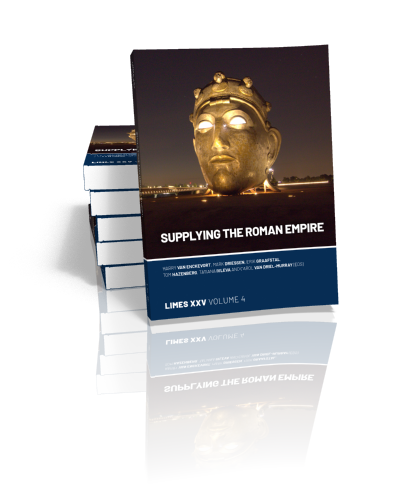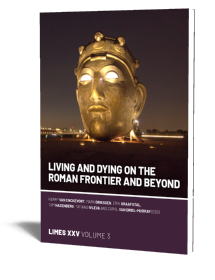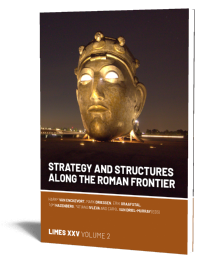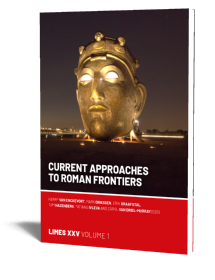Supplying the Roman Empire (LIMES XXV volume 4)
Proceedings of the 25th International Congress of Roman Frontier Studies 4
Edited by Harry van Enckevort, Mark Driessen, Erik Graafstal, Tom Hazenberg, Tatiana Ivleva and Carol van Driel-Murray | 2024

Supplying the Roman Empire (LIMES XXV volume 4)
Proceedings of the 25th International Congress of Roman Frontier Studies 4
Edited by Harry van Enckevort, Mark Driessen, Erik Graafstal, Tom Hazenberg, Tatiana Ivleva and Carol van Driel-Murray | 2024
Paperback ISBN: 9789464262841 | Hardback ISBN: 9789464262858 | Imprint: Sidestone Press | Format: 210x280mm | 386 pp. | Language: English | 23 illus. (bw) | 157 illus. (fc) | Keywords: archaeology; Roman Empire; Roman frontiers; limes; Roman army; military supply and control; logistics; material culture | download cover | DOI: 10.59641/mm723py
Read online or downloaded 2516 times
-
Digital & Online access
This is a full Open Access publication, click below to buy in print, browse, or download for free.
-
Buy via Sidestone (EU & UK)
-
Buy via our Distributors (WORLD)
For non-EU or UK destinations you can buy our books via our international distributors. Although prices may vary this will ensure speedy delivery and reduction in shipping costs or import tax. But you can also order with us directly via the module above.
UK international distributor
USA international distributor
-
Bookinfo
Paperback ISBN: 9789464262841 | Hardback ISBN: 9789464262858 | Imprint: Sidestone Press | Format: 210x280mm | 386 pp. | Language: English | 23 illus. (bw) | 157 illus. (fc) | Keywords: archaeology; Roman Empire; Roman frontiers; limes; Roman army; military supply and control; logistics; material culture | download cover | DOI: 10.59641/mm723py
Read online or downloaded 2516 times

We will plant a tree for each order containing a paperback or hardback book via OneTreePlanted.org.
This publication – Supplying the Roman Empire – is the fourth volume of the LIMES XXV’s congress proceedings and deals with various aspects of the supply and provisioning of the Roman empire, and the role of the Roman armies housed on its fringes herein. The result is a wide-ranging collection of papers dealing with topics such as: finds of organic material; riverine and maritime supply and security; militarily controlled mining; building material procurement and processing; agro-political schemes and water management; military material culture. The proceedings are all arranged around the original sessions, trying to create coherent thematical collections that make the vast output more accessible to generalists and specialists alike.
Frontiers are zones, or lines, of contact and coercion, of exchange and exclusion. As such they often express some of the most typical elements of the socio-political spaces that are defined by them. Spanning some 6,000 km along rivers, mountain ranges, artificial barriers and fringes of semi-desert, the frontiers of the Roman empire offer a wide variety of avenues and topics for a very diverse community of scholars. They are the central subject of the International Congress of Roman Frontier Studies (or just Limes Congress after the Latin word for ‘border’), organised every three years since 1949. This four-volume publication contains most of the papers presented at the 25th edition which was hosted by the municipality of Nijmegen in August 2022.
Find all four volumes of the LIMES XXV Proceedings here.
About the editors
Dr. Harry van Enckevort has been researching the (Roman) past of Nijmegen as an archaeologist since 1990. The first years he worked for the State Service for Archaeological Investigations in the Netherlands (ROB), then for the municipality of Nijmegen, and since the end of 2022 as an independent researcher.
Dr.ir. Mark Driessen, Assistant Professor at the Faculty of Archaeology – Leiden University (2011-now); Udhruh Archaeological Project (2011-now).
Erik P. Graafstal (MA), Municipal archaeologist and Director of Museum Hoge Woerd, Utrecht.
Tom Hazenberg (MA), independent archeologist for Hazenberg Archeologie & Coordinator Research and Preservation for the Dutch Limes Association; Project Restoration Collection Roman Ships of Zwammerdam and development of the National Roman Maritime Museum at Museumpark Archeon (2010 – now).
Dr. Tatiana Ivleva is Visiting Research Fellow at Newcastle University (UK).
Dr. Carol van Driel-Murray, Formerly lecturer Provincial Roman Archaeology, Faculty of Archaeology, University of Leiden (retired).
Preface
Who were the Logisticians? Dispensatores, imperial agents supplying the army
Stephen R. Matthews
Part 1. Organic riches. The impact of organic resources on frontier research
Organic riches. The contribution of organic materials to the understanding of frontier dynamics
Carol van Driel-Murray
An integrated study of organic archaeological environments at Vindolanda. A case-study from the 2nd-century extramural settlement
Elizabeth M. Greene and Barbara Birley
From tree to post. Logistics and organisation around infrastructural works in the Lower Germanic Limes
Silke Lange
Wood, Craft, and People. The potential and challenges of wooden objects from Roman contexts
Rob Sands
Em)bedding the Romans. Rare fragments of a Roman bed in the extra-mural settlement of Marktveld-Weerdkampen, Valkenburg, Zuid-Holland (the Netherlands)
Tamara J.J. Vernimmen, Stephan T.A.M. Mols, Jeroen Loopik and Wouter K. Vos
As good as new? A remarkable find of wooden roof-shingles from Houten, the Netherlands
Ivo Vossen, Tamara J.J. Vernimmen and Sjoerd van Daalen
Part 2. ‘Ripae et litora’. Supply and security on the riverine and coastal edges of the Roman Empire
The River Main (Hesse/Germany) as route of military supply. New archaeological and geoarchaeological research
Thomas Becker, Andreas Vött, Lea Obrocki and Anna-Lena Dixius
The castra Velsen 2
Arjen V.A.J. Bosman
The Roman sea frontier along the Channel and North Sea. Development, nature, tactics, and strategy
Wouter Dhaeze
Were there any repairs to the Rhine bridge Colonia Agrippina. Divitia at the end of the 4th century AD under the magister militum Arbogast the Elder? Dendrochronological data and historical classification
Norbert Hanel and Thomas Frank
Investigating Corbulo’s Canal. A situation report
Wilfried A.M. Hessing
Prisoners of ethno-geography. Transnational dynamics of warfare between Late Iron Age Ireland and the Roman frontier in Britain, 122-163 AD
Al McCluskey
When’s a fleet a fleet? Classes and legions on the water
Christoph Rummel
Defending dunes. Details of the Antonine coastal limes between Rhine and Meuse
Jeroen van Zoolingen
Securing transport of wood over water on the Roman Rhine
Ronald M. Visser
Part 3. Rome’s hunger for metals. Roman mining in and outside the provinces and the part of the Roman military
Roman army and mining
Markus Scholz
Under the eyes of the Roman army. Early imperial mining on the Lower Lahn river (D)
Frederic Auth, Daniel Burger-Völlmecke, Peter Henrich and Markus Scholz
Casting the smith in a new light. Using social theories of technology to understand of Roman military metalworking
Amy J. Baker
A new Roman camp north of the Lower German Limes at Ermelo (The Netherlands)
Mark Driessen and Wouter Verschoof-van der Vaart
The Roman army in the Oriental Pyrenees (2nd-1st century BC). Territorial control and management of provincial resources in the High Lands
Oriol Olesti Vila, Joan Oller Guzmán and Jordi Morera Camprubí
Von Bergleuten, Händlern und römischem Militär im Lahntal (D)
Gabriele Rasbach
Part 4. Brickyards and limes kilns of the Roman army
The brickyards of Legio IIII Flavia Felix in Dacia in the early 2nd century AD
Alexandru Flutur
The newly excavated brick and tile kiln in the Vindolanda North Field
Craig A. Harvey and Elizabeth M. Greene
The Saalburg Tile Kiln Project. Making Roman ceramic building materials the whole way
Rüdiger Schwarz
The lime kilns of Legio II Italica in Lauriacum/Enns (Noricum)
Stefan Traxler, Felix Lang, Herbert Böhm and Gerald Grabherr
Part 5. Water and agriculture
The aqueduct of Noviomagus
Paul M. Kessener
Material traces of viticulture in Southern Pannonia
Jana Kopáčková and Hana Ivezić
The Chesters road bridge and wharf on Hadrian’s Wall
Ian Longhurst
Organization of the water supply for the Trajanic frontier fort in the Nabataean settlement of Hawara (Southern Jordan)
John Peter Oleson and Craig A. Harvey
Vessels with the handle above the opening from Lower Pannonia and Upper Moesia
Ivana Ožanić Roguljić and Angelina Raičković Savić
Irrigating the land, provisioning the caravans. Water decline and military settlement at el-Deir (Kharga Oasis, Western Desert of Egypt), 3rd-5th century AD
Gaëlle Tallet and Jean-Paul Bravard
Erd-Reich – Earthen Empire. Eine Übersicht zu neuen, geoarchäologischen Untersuchungen zum Rasensodenbau am römischen Limes
Tanja Romankiewicz, Ben Russell, Christopher T.S. Beckett, J. Riley Snyder and Rose Ferraby
Part 6. Small finds everywhere
Water and control along the later Roman Empire’s south-eastern border
Walter D. Ward
The Jets vs. the Sharks, a story from the west side of Vindonissa. Comparison of two brooch assemblages from the civil settlement West
Hannes Flück
New insights into the distribution of Roman metal finds in the Netherlands with PAN
Stefanie Hoss
Rittium – Surduk
Hana Ivezić and Jana Kopáčková
Hier auch! Webgewichte in den Legionslagern Neuss und Bonn
Tünde Kaszab-Olschewski
Military small finds from Castra Ad Fluvium Frigidum (Slovenia)
Ana R. Kovačič and Maruša Urek
Militaria in the Cantabrian Wars. The Carisa axis of operations. The cases of Ḷḷagüezos and A Cuaña
Esperanza Martín Hernández
The Roman army on the Rhine and the monetization of the rural hinterland
Rahel Otte
Military equipment and horse gear from the Nijmegen castra and canabae legionis
Vincent van der Veen
Semi-rigid scale armour. Characteristics, dating and distribution of a Roman body armour
Martijn A. Wijnhoven
Military artefacts in the civil province of Britannia. A case study: Trompetenmuster mounts
Edwin Wood
Abstract:
This publication – Supplying the Roman Empire – is the fourth volume of the LIMES XXV’s congress proceedings and deals with various aspects of the supply and provisioning of the Roman empire, and the role of the Roman armies housed on its fringes herein. The result is a wide-ranging collection of papers dealing with topics such as: finds of organic material; riverine and maritime supply and security; militarily controlled mining; building material procurement and processing; agro-political schemes and water management; military material culture. The proceedings are all arranged around the original sessions, trying to create coherent thematical collections that make the vast output more accessible to generalists and specialists alike.
Frontiers are zones, or lines, of contact and coercion, of exchange and exclusion. As such they often express some of the most typical elements of the socio-political spaces that are defined by them. Spanning some 6,000 km along rivers, mountain ranges, artificial barriers and fringes of semi-desert, the frontiers of the Roman empire offer a wide variety of avenues and topics for a very diverse community of scholars. They are the central subject of the International Congress of Roman Frontier Studies (or just Limes Congress after the Latin word for ‘border’), organised every three years since 1949. This four-volume publication contains most of the papers presented at the 25th edition which was hosted by the municipality of Nijmegen in August 2022.
Find all four volumes of the LIMES XXV Proceedings here.
About the editors
Dr. Harry van Enckevort has been researching the (Roman) past of Nijmegen as an archaeologist since 1990. The first years he worked for the State Service for Archaeological Investigations in the Netherlands (ROB), then for the municipality of Nijmegen, and since the end of 2022 as an independent researcher.
Dr.ir. Mark Driessen, Assistant Professor at the Faculty of Archaeology – Leiden University (2011-now); Udhruh Archaeological Project (2011-now).
Erik P. Graafstal (MA), Municipal archaeologist and Director of Museum Hoge Woerd, Utrecht.
Tom Hazenberg (MA), independent archeologist for Hazenberg Archeologie & Coordinator Research and Preservation for the Dutch Limes Association; Project Restoration Collection Roman Ships of Zwammerdam and development of the National Roman Maritime Museum at Museumpark Archeon (2010 – now).
Dr. Tatiana Ivleva is Visiting Research Fellow at Newcastle University (UK).
Dr. Carol van Driel-Murray, Formerly lecturer Provincial Roman Archaeology, Faculty of Archaeology, University of Leiden (retired).
Contents
Preface
Who were the Logisticians? Dispensatores, imperial agents supplying the army
Stephen R. Matthews
Part 1. Organic riches. The impact of organic resources on frontier research
Organic riches. The contribution of organic materials to the understanding of frontier dynamics
Carol van Driel-Murray
An integrated study of organic archaeological environments at Vindolanda. A case-study from the 2nd-century extramural settlement
Elizabeth M. Greene and Barbara Birley
From tree to post. Logistics and organisation around infrastructural works in the Lower Germanic Limes
Silke Lange
Wood, Craft, and People. The potential and challenges of wooden objects from Roman contexts
Rob Sands
Em)bedding the Romans. Rare fragments of a Roman bed in the extra-mural settlement of Marktveld-Weerdkampen, Valkenburg, Zuid-Holland (the Netherlands)
Tamara J.J. Vernimmen, Stephan T.A.M. Mols, Jeroen Loopik and Wouter K. Vos
As good as new? A remarkable find of wooden roof-shingles from Houten, the Netherlands
Ivo Vossen, Tamara J.J. Vernimmen and Sjoerd van Daalen
Part 2. ‘Ripae et litora’. Supply and security on the riverine and coastal edges of the Roman Empire
The River Main (Hesse/Germany) as route of military supply. New archaeological and geoarchaeological research
Thomas Becker, Andreas Vött, Lea Obrocki and Anna-Lena Dixius
The castra Velsen 2
Arjen V.A.J. Bosman
The Roman sea frontier along the Channel and North Sea. Development, nature, tactics, and strategy
Wouter Dhaeze
Were there any repairs to the Rhine bridge Colonia Agrippina. Divitia at the end of the 4th century AD under the magister militum Arbogast the Elder? Dendrochronological data and historical classification
Norbert Hanel and Thomas Frank
Investigating Corbulo’s Canal. A situation report
Wilfried A.M. Hessing
Prisoners of ethno-geography. Transnational dynamics of warfare between Late Iron Age Ireland and the Roman frontier in Britain, 122-163 AD
Al McCluskey
When’s a fleet a fleet? Classes and legions on the water
Christoph Rummel
Defending dunes. Details of the Antonine coastal limes between Rhine and Meuse
Jeroen van Zoolingen
Securing transport of wood over water on the Roman Rhine
Ronald M. Visser
Part 3. Rome’s hunger for metals. Roman mining in and outside the provinces and the part of the Roman military
Roman army and mining
Markus Scholz
Under the eyes of the Roman army. Early imperial mining on the Lower Lahn river (D)
Frederic Auth, Daniel Burger-Völlmecke, Peter Henrich and Markus Scholz
Casting the smith in a new light. Using social theories of technology to understand of Roman military metalworking
Amy J. Baker
A new Roman camp north of the Lower German Limes at Ermelo (The Netherlands)
Mark Driessen and Wouter Verschoof-van der Vaart
The Roman army in the Oriental Pyrenees (2nd-1st century BC). Territorial control and management of provincial resources in the High Lands
Oriol Olesti Vila, Joan Oller Guzmán and Jordi Morera Camprubí
Von Bergleuten, Händlern und römischem Militär im Lahntal (D)
Gabriele Rasbach
Part 4. Brickyards and limes kilns of the Roman army
The brickyards of Legio IIII Flavia Felix in Dacia in the early 2nd century AD
Alexandru Flutur
The newly excavated brick and tile kiln in the Vindolanda North Field
Craig A. Harvey and Elizabeth M. Greene
The Saalburg Tile Kiln Project. Making Roman ceramic building materials the whole way
Rüdiger Schwarz
The lime kilns of Legio II Italica in Lauriacum/Enns (Noricum)
Stefan Traxler, Felix Lang, Herbert Böhm and Gerald Grabherr
Part 5. Water and agriculture
The aqueduct of Noviomagus
Paul M. Kessener
Material traces of viticulture in Southern Pannonia
Jana Kopáčková and Hana Ivezić
The Chesters road bridge and wharf on Hadrian’s Wall
Ian Longhurst
Organization of the water supply for the Trajanic frontier fort in the Nabataean settlement of Hawara (Southern Jordan)
John Peter Oleson and Craig A. Harvey
Vessels with the handle above the opening from Lower Pannonia and Upper Moesia
Ivana Ožanić Roguljić and Angelina Raičković Savić
Irrigating the land, provisioning the caravans. Water decline and military settlement at el-Deir (Kharga Oasis, Western Desert of Egypt), 3rd-5th century AD
Gaëlle Tallet and Jean-Paul Bravard
Erd-Reich – Earthen Empire. Eine Übersicht zu neuen, geoarchäologischen Untersuchungen zum Rasensodenbau am römischen Limes
Tanja Romankiewicz, Ben Russell, Christopher T.S. Beckett, J. Riley Snyder and Rose Ferraby
Part 6. Small finds everywhere
Water and control along the later Roman Empire’s south-eastern border
Walter D. Ward
The Jets vs. the Sharks, a story from the west side of Vindonissa. Comparison of two brooch assemblages from the civil settlement West
Hannes Flück
New insights into the distribution of Roman metal finds in the Netherlands with PAN
Stefanie Hoss
Rittium – Surduk
Hana Ivezić and Jana Kopáčková
Hier auch! Webgewichte in den Legionslagern Neuss und Bonn
Tünde Kaszab-Olschewski
Military small finds from Castra Ad Fluvium Frigidum (Slovenia)
Ana R. Kovačič and Maruša Urek
Militaria in the Cantabrian Wars. The Carisa axis of operations. The cases of Ḷḷagüezos and A Cuaña
Esperanza Martín Hernández
The Roman army on the Rhine and the monetization of the rural hinterland
Rahel Otte
Military equipment and horse gear from the Nijmegen castra and canabae legionis
Vincent van der Veen
Semi-rigid scale armour. Characteristics, dating and distribution of a Roman body armour
Martijn A. Wijnhoven
Military artefacts in the civil province of Britannia. A case study: Trompetenmuster mounts
Edwin Wood
-
Digital & Online access
This is a full Open Access publication, click below to buy in print, browse, or download for free.
-
Buy via Sidestone (EU & UK)
-
Buy via our Distributors (WORLD)
For non-EU or UK destinations you can buy our books via our international distributors. Although prices may vary this will ensure speedy delivery and reduction in shipping costs or import tax. But you can also order with us directly via the module above.
UK international distributor
USA international distributor
- Browse all books by subject
-
Search all books

We will plant a tree for each order containing a paperback or hardback book via OneTreePlanted.org.
You might also like:
© 2025 Sidestone Press KvK nr. 28114891 Privacy policy Sidestone Newsletter Terms and Conditions (Dutch)








